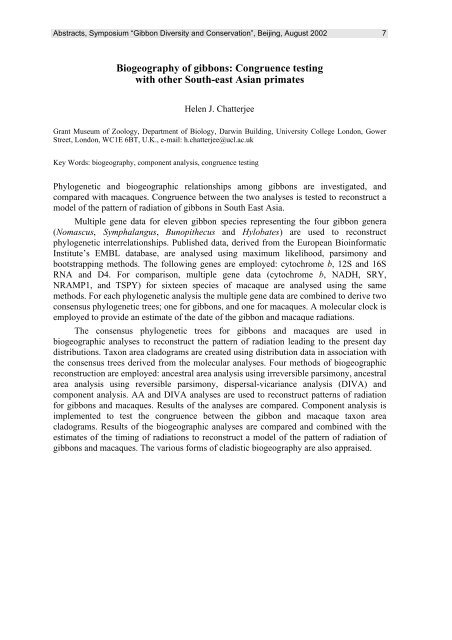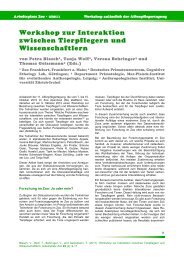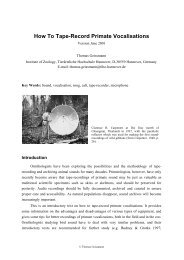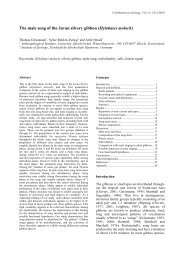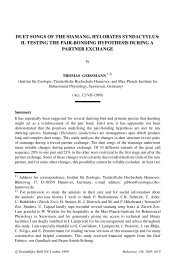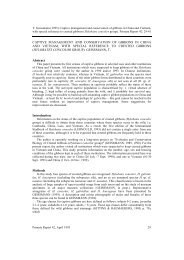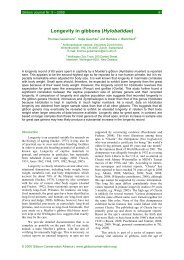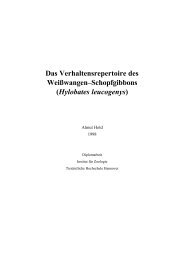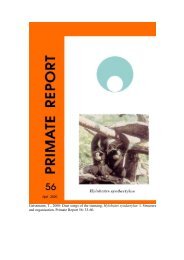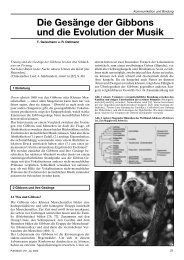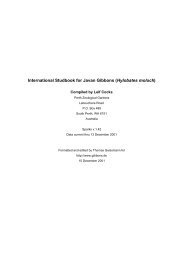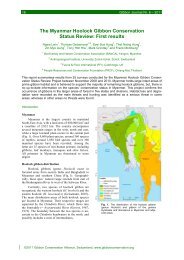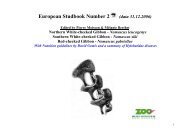Abstracts, Symposium “<strong>Gibbon</strong> Diversity and Conservation”, Beijing, August 2002 7Biogeography of gibbons: Congruence testingwith other South-east Asian primatesHelen J. ChatterjeeGrant Museum of Zoology, Department of Biology, Darwin Building, University College London, GowerStreet, London, WC1E 6BT, U.K., e-mail: h.chatterjee@ucl.ac.ukKey Words: biogeography, component analysis, congruence testingPhylogenetic and biogeographic relationships among gibbons are investigated, andcompared with macaques. Congruence between the two analyses is tested to reconstruct amodel of the pattern of radiation of gibbons in South East Asia.Multiple gene data for eleven gibbon species representing the four gibbon genera(Nomascus, Symphalangus, Bunopithecus and Hylobates) are used to reconstructphylogenetic interrelationships. Published data, derived from the European BioinformaticInstitute’s EMBL database, are analysed using maximum likelihood, parsimony andbootstrapping methods. The following genes are employed: cytochrome b, 12S and 16SRNA and D4. For comparison, multiple gene data (cytochrome b, NADH, SRY,NRAMP1, and TSPY) for sixteen species of macaque are analysed using the samemethods. For each phylogenetic analysis the multiple gene data are combined to derive twoconsensus phylogenetic trees; one for gibbons, and one for macaques. A molecular clock isemployed to provide an estimate of the date of the gibbon and macaque radiations.The consensus phylogenetic trees for gibbons and macaques are used inbiogeographic analyses to reconstruct the pattern of radiation leading to the present daydistributions. Taxon area cladograms are created using distribution data in association withthe consensus trees derived from the molecular analyses. Four methods of biogeographicreconstruction are employed: ancestral area analysis using irreversible parsimony, ancestralarea analysis using reversible parsimony, dispersal-vicariance analysis (DIVA) andcomponent analysis. AA and DIVA analyses are used to reconstruct patterns of radiationfor gibbons and macaques. Results of the analyses are compared. Component analysis isimplemented to test the congruence between the gibbon and macaque taxon areacladograms. Results of the biogeographic analyses are compared and combined with theestimates of the timing of radiations to reconstruct a model of the pattern of radiation ofgibbons and macaques. The various forms of cladistic biogeography are also appraised.
Abstracts, Symposium “<strong>Gibbon</strong> Diversity and Conservation”, Beijing, August 2002 8Assessing the viability of rehabilitation and reintroduction of ex-captivegibbons (Hylobates agilis albibarbis and Hylobates muelleri ssp.) inIndonesian BorneoSusan M. CheyneWildlife <strong>Research</strong> Group, Department of Anatomy, University of Cambridge, Downing Street, CambridgeCB2 3DY, U.K., e-mail: fael_inis@hotmail.comField address: Kalaweit Care Centre, Jl. Pinus No. 14, Palangka Raya, Kalteng, Indonesia.Key Words: gibbons, rehabilitation, IndonesiaThe past 30 years have seen vast resources/research time focusing onrehabilitation/reintroduction of orang-utans throughout their home range. Until now, allsimilar efforts to rehabilitate ex-captive gibbons have been educated guesswork,accompanied up by little or no pre-release assessment of the suitability of the individualsinvolved, or follow-up monitoring. The only report on a gibbon rehabilitation project inThailand states that all releases failed, probably due to the poor quality relationshipsbetween the released adults. Most releases from this project have been based on subjectiveimpression and not objective scientific data. Until this issue is addressed, many releasedgibbons will continue to perish, having contributed nothing to the survival potential of thespecies.A study was initiated in March 2002 to begin systematic behavioural assessment ofex-captive gibbons being rehabilitated at the Kalaweit Programme, Central Kalimantan.Upon arrival at Kalaweit, all gibbons are placed in quarantine cages to undergo medicaltesting: for TB (anti TB Igg), HepBsAb, HepBsAg, anit-HSV1 and anti-HSV2 antibodies.<strong>Gibbon</strong>s are housed alone until results are known. Healthy gibbons are transported to t<strong>here</strong>habilitation site located in the Bukit Baka/Bukit Raya National Park. Only maturesubadults and adults are considered for release.Initial findings on feeding and social behaviour, and activity patterns of the excaptivesare presented, with comparisons to wild populations. The validity of the results astools for identifying if (a) an individual is suitable for rehabilitation and (b) a pair issuitable for release, are appraised. Also presented are future research plans and how thepreliminary data is being used to plan future releases and pair compatible individuals atKalaweit.I suggest that several factors in the individual’s life history may be involved in thedifferences between the gibbons’ performances in the rehabilitation process.
- Page 1 and 2: Thomas GeissmannInstitut für Zoolo
- Page 3 and 4: Symposium “Gibbon Diversity and C
- Page 5 and 6: Abstracts, Symposium “Gibbon Dive
- Page 7 and 8: Abstracts, Symposium “Gibbon Dive
- Page 9: Abstracts, Symposium “Gibbon Dive
- Page 13 and 14: Abstracts, Symposium “Gibbon Dive
- Page 15 and 16: Abstracts, Symposium “Gibbon Dive
- Page 18 and 19: Abstracts, Symposium “Gibbon Dive
- Page 20 and 21: Abstracts, Symposium “Gibbon Dive
- Page 22 and 23: Abstracts, Symposium “Gibbon Dive
- Page 24 and 25: Abstracts, Symposium “Gibbon Dive
- Page 26 and 27: Abstracts, Symposium “Gibbon Dive
- Page 28 and 29: Abstracts, Symposium “Gibbon Dive
- Page 30 and 31: Abstracts, Symposium “Gibbon Dive
- Page 32 and 33: Abstracts, Symposium “Gibbon Dive
- Page 34 and 35: Abstracts, Symposium “Gibbon Dive


